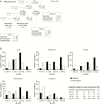Management evaluation of metastasis in the brain (MEMBRAIN)-a United Kingdom and Ireland prospective, multicenter observational study
- PMID: 32537183
- PMCID: PMC7274191
- DOI: 10.1093/nop/npz063
Management evaluation of metastasis in the brain (MEMBRAIN)-a United Kingdom and Ireland prospective, multicenter observational study
Abstract
Background: In recent years an increasing number of patients with cerebral metastasis (CM) have been referred to the neuro-oncology multidisciplinary team (NMDT). Our aim was to obtain a national picture of CM referrals to assess referral volume and quality and factors affecting NMDT decision making.
Methods: A prospective multicenter cohort study including all adult patients referred to NMDT with 1 or more CM was conducted. Data were collected in neurosurgical units from November 2017 to February 2018. Demographics, primary disease, KPS, imaging, and treatment recommendation were entered into an online database.
Results: A total of 1048 patients were analyzed from 24 neurosurgical units. Median age was 65 years (range, 21-93 years) with a median number of 3 referrals (range, 1-17 referrals) per NMDT. The most common primary malignancies were lung (36.5%, n = 383), breast (18.4%, n = 193), and melanoma (12.0%, n = 126). A total of 51.6% (n = 541) of the referrals were for a solitary metastasis and resulted in specialist intervention being offered in 67.5% (n = 365) of cases. A total of 38.2% (n = 186) of patients being referred with multiple CMs were offered specialist treatment. NMDT decision making was associated with number of CMs, age, KPS, primary disease status, and extent of extracranial disease (univariate logistic regression, P < .001) as well as sentinel location and tumor histology (P < .05). A delay in reaching an NMDT decision was identified in 18.6% (n = 195) of cases.
Conclusions: This study demonstrates a changing landscape of metastasis management in the United Kingdom and Ireland, including a trend away from adjuvant whole-brain radiotherapy and specialist intervention being offered to a significant proportion of patients with multiple CMs. Poor quality or incomplete referrals cause delay in NMDT decision making.
Keywords: BNTRC; brain tumor, metastasis; multidisciplinary team.
© The Author(s) 2019. Published by Oxford University Press on behalf of the Society for Neuro-Oncology and the European Association of Neuro-Oncology. All rights reserved. For permissions, please e-mail: journals.permissions@oup.com.
Figures

References
-
- National Institute for Health and Clinical Excellence. Brain tumours (primary) and brain metastases in adults.2006.https://www.nice.org.uk/guidance/indevelopment/gid-ng10003. Accessed March 28, 2019.
-
- National Institute for Health and Clinical Excellence. Improving outcomes for people with brain and other CNS tumours. Clinical guideline.2006.https://www.nice.org.uk/guidance/csg10. Accessed March 28, 2019.
-
- Panesar S, Tailor J, Bhangoo R, Ashkan K.. Multidisciplinary team management of cerebral metastases: recent trends and future implications. Clin Oncol (R Coll Radiol). 2016;28(5):343–344. - PubMed
-
- Tabouret E, Chinot O, Metellus P, Tallet A, Viens P, Gonçalves A. Recent trends in epidemiology of brain metastases: an overview. Anticancer Res. 2012;32(11):4655–4662. - PubMed
-
- D’Andrea G, Palombi L, Minniti G, Pesce A, Marchetti P.. Brain metastases: surgical treatment and overall survival. World Neurosurg. 2017;97:169–177. - PubMed

